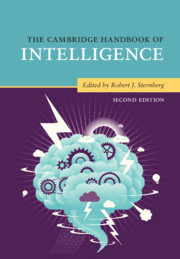Book contents
- The Cambridge Handbook of Intelligence
- The Cambridge Handbook of Intelligence
- Copyright page
- Dedication
- Contents
- Figures
- Tables
- Contributors
- Preface
- Part I Intelligence and Its Measurement
- Part II Development of Intelligence
- 6 Genetic Bases of Intelligence
- 7 Intelligence in Infancy
- 8 Intelligence in Childhood
- 9 Intelligence in Adulthood
- 10 Developing Intelligence through Instruction
- Part III Intelligence and Group Differences
- Part IV Biology of Intelligence
- Part V Intelligence and Information Processing
- Part VI Kinds of Intelligence
- Part VII Intelligence and Its Role in Society
- Part VIII Intelligence and Allied Constructs
- Part IX Folk Conceptions of Intelligence
- Part X Conclusion
- Author Index
- Subject Index
- References
9 - Intelligence in Adulthood
from Part II - Development of Intelligence
Published online by Cambridge University Press: 13 December 2019
- The Cambridge Handbook of Intelligence
- The Cambridge Handbook of Intelligence
- Copyright page
- Dedication
- Contents
- Figures
- Tables
- Contributors
- Preface
- Part I Intelligence and Its Measurement
- Part II Development of Intelligence
- 6 Genetic Bases of Intelligence
- 7 Intelligence in Infancy
- 8 Intelligence in Childhood
- 9 Intelligence in Adulthood
- 10 Developing Intelligence through Instruction
- Part III Intelligence and Group Differences
- Part IV Biology of Intelligence
- Part V Intelligence and Information Processing
- Part VI Kinds of Intelligence
- Part VII Intelligence and Its Role in Society
- Part VIII Intelligence and Allied Constructs
- Part IX Folk Conceptions of Intelligence
- Part X Conclusion
- Author Index
- Subject Index
- References
Summary
Adult intellectual development is known to produce a pattern of average age-related changes differing by whether the ability in question is dominated by acquired knowledge (crystallized intelligence) or by processes involved in reasoning and memory, especially working memory (fluid intelligence). Other differentiable abilities, like spatial visualization, also show average age-related decline. Both classes of abilities have shown substantial generational differences, with more recently born individuals showing better performance on tests of intellectual abilities. Genetic influences play a role in determining age-related change, but other factors are also at play. There is substantial stability of individual differences in intellectual abilities, showing that aging does not radically alter profiles of abilities seen in early adulthood. There are individual differences in magnitudes of age-related changes that are exacerbated by nonnormative age-related diseases (e.g., cardiovascular disease, Type 2 diabetes), life events, health-degrading behaviors (e.g., tobacco use), and late-life terminal decline. Individual differences in rates of age-related change are partly general (manifested for all abilities) but also ability specific (different persons showing decline on some abilities but not others), perhaps indicating multiple influences on age-related changes. At present it is unknown how much of the observed age-related decline could be mitigated by lifestyle and behavioral interventions prior to the period of late-life disablement. Age-related changes in fluid intelligence do not necessarily translate into functional impairment in demanding everyday activities, given the critical role that knowledge and experience play in self-regulation.
Information
- Type
- Chapter
- Information
- The Cambridge Handbook of Intelligence , pp. 181 - 204Publisher: Cambridge University PressPrint publication year: 2020
